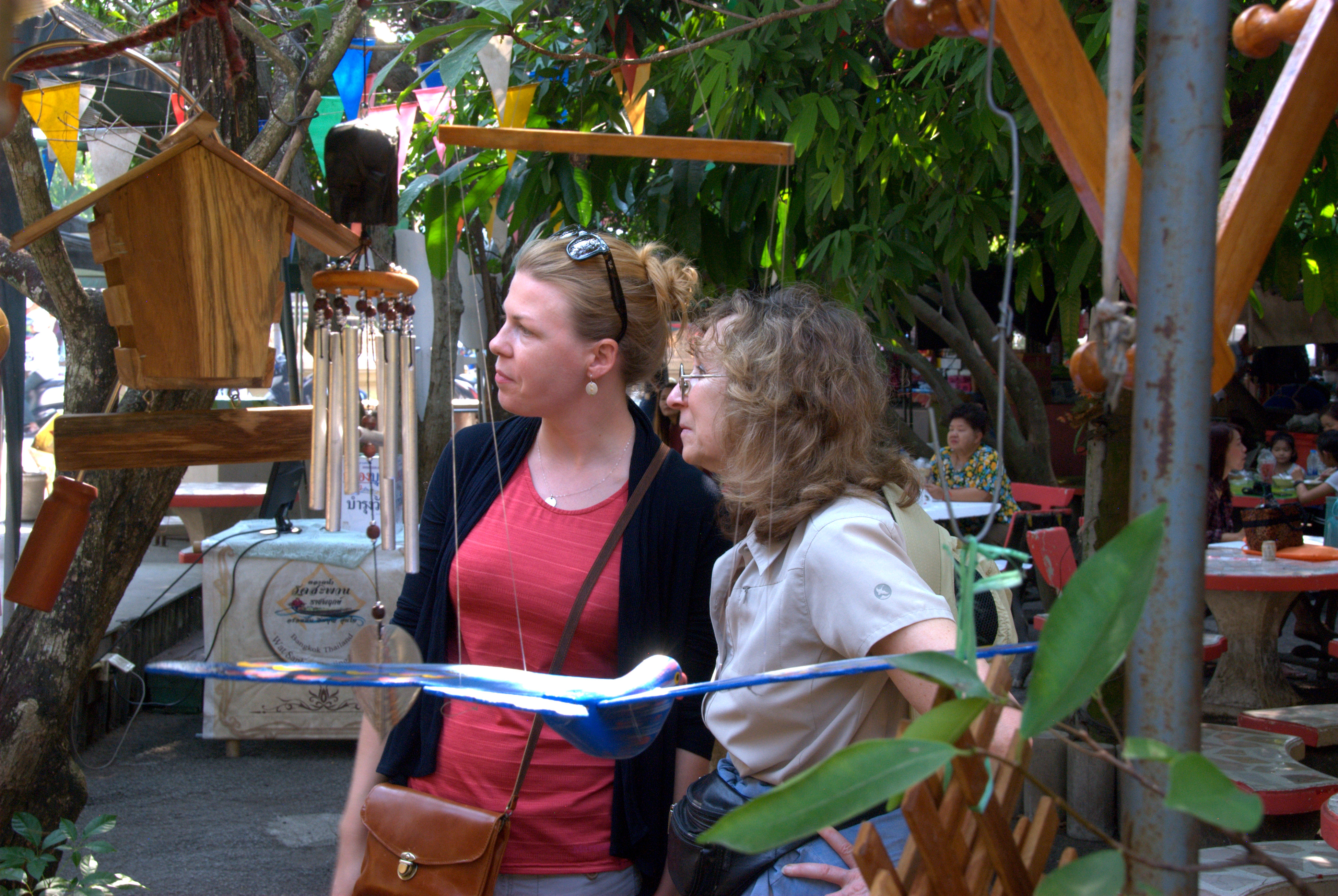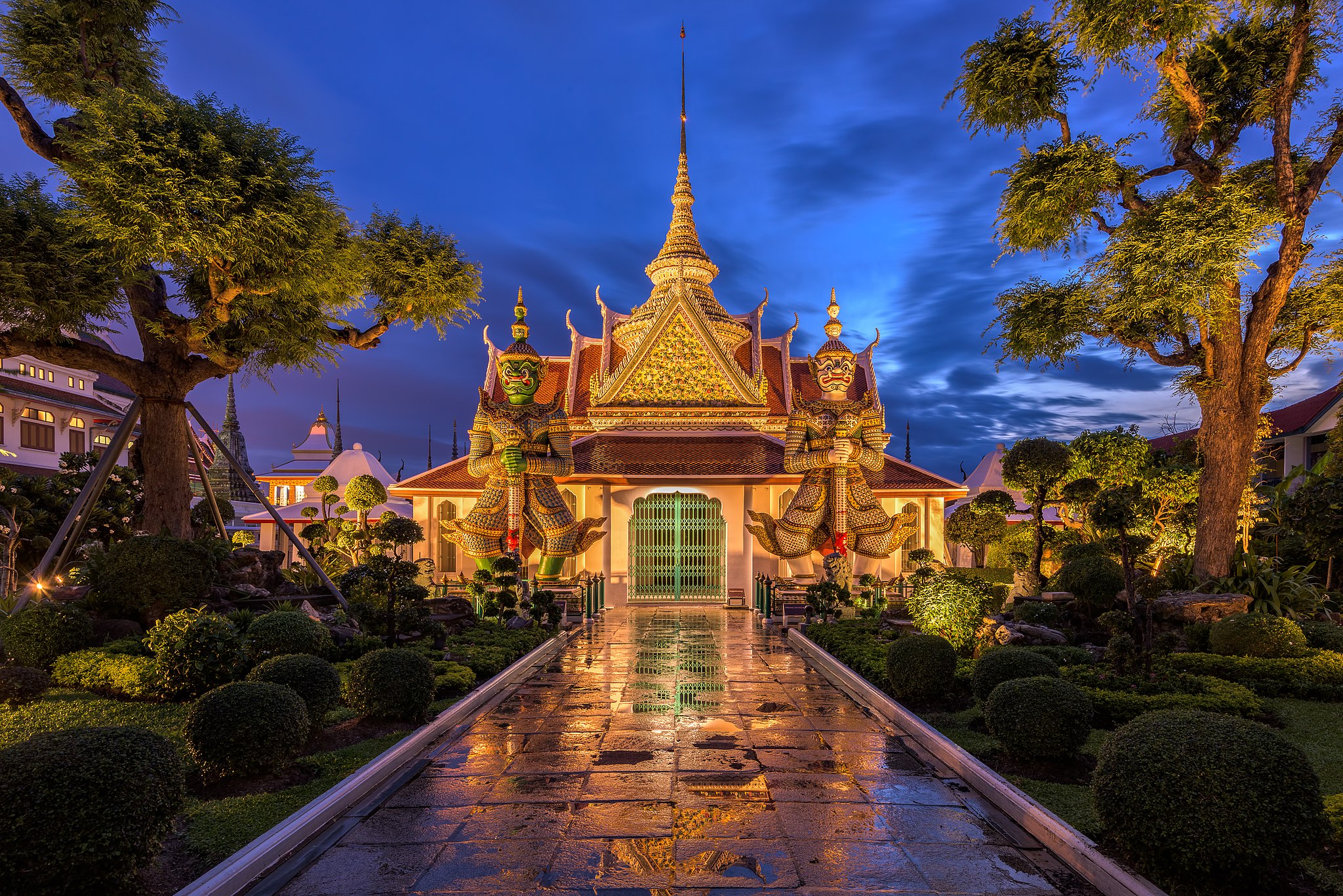Worlds Between Worlds
By Sy Montgomery, Author and Naturalist
Renowned author Sy Montgomery has arrived in Bangkok to join the expedition Tracking Asiatic Wild Dogs in Thailand. Before heading into the field, she took a couple of days to explore the city, including a visit to the Buddhist temple Wat Arun (the Temple of Dawn). Tomorrow, Sy travels to Khao Yai National Park with the Earthwatch team. Stay tuned for more stories from her adventures.

Sy in Thailand. (Courtesy Roger Wood)
BANGKOK — I’ve been away from this vibrant Southeast Asian city so long they’ve built a new airport since I was last here. But just minutes into the taxi ride into town, Bangkok seems to welcome me back like an old friend, embracing me with its wet heat and its riotous orchids, its skyline of golden pagodas and steel skyscrapers. Street vendors hawk batiks, savory satays, and fruits that look like they grew on Mars. The air smells of incense and car exhaust and fermented fish paste.
The last time I was in town, more than 15 years ago, I was drawn by the same creature that brings me today: dholes, the Asiatic wild dogs whose vast former range has shrunk so alarmingly that they are now considered one of the five most endangered canids on Earth. I’d flown into Bangkok on my way to Laos, where I’d come to meet my friend, an expat ethnolinguist named Jim Chamberlain, who was to take me by helicopter to a remote location known only to him. Amid the Annamite Range, years earlier, he had met a previously undocumented tribe of hunter-gatherers, who hunted by following dholes and sharing their kills. Instead of taking me to them, though, Jim promptly had a heart attack. Fortunately, he survived but scuttled the expedition. Now, thanks to an Earthwatch fellowship, I find myself on the trail of these enigmatic dogs again. I’m here to join Thai researchers studying radio-collared animals at the country’s first and best-loved national park, Khao Yai, where dholes are the ecosystem’s top predator. I expect better luck this time.
Still, it seems wise, at the dawn of a new adventure, to ask for a blessing. What better place to go first than to Wat Arun – one of Bangkok’s most spectacular sights – known as the Temple of Dawn. It’s just across the Chao Phraya River from our hotel. A five-minute ride by ferry brings me and Earthwatch’s communications director Alix Morris – a tall, blonde 35-year-old who just returned from an expedition to Mongolia in September – to the temple complex that for centuries has honored the ancient Hindu god, Aruna, lord of the rising sun. Kings have repeatedly enlarged and embellished its structures. It seems that every inch of every surface tells a story we can not understand and bears witness to some impenetrable wonder. The largest, central pagoda is perhaps the most whimsical. In the 19th, century King Rama IV covered it with distinctive mosaics made of broken bits of Chinese porcelain, much of it in greens and blues, donated by local people.

The entire complex is guarded by statues of warriors, goats, dragons, water serpents, angels, and demon-bears; it glitters with mirrors; and, one of the few plaques in English tells us, “The first light of the morning reflects off the surface of the temple with pearly iridescence.”
Alix and I stand stupefied in the noon heat. Staring at the intricate murals and mosaics, the riot of statuary, the glitter of gold leaf and mirrors, we are overwhelmed. We are meant to be. The tallest structure is meant to evoke Mount Meru, the Hindu and Buddhist vision of the cosmos itself. The central pagoda’s ornamental tiers denote worlds within worlds: Six heavens. Seven realms of happiness. Thirty-one realms of existence. The three worlds of Desire, Form, and Formlessness.
Here in this sacred space, we are confronted, too, with our modern, largely Westernized world. Though most of the plaques are written in the softly curving Thai alphabet and impenetrable to us, English signs warn tourists that photo-taking drones are not allowed in this holy space; neither are sleeveless shirts or short skirts, which are considered disrespectful.

The pitiless sun finally drives us back to the ferry and to the cool of our hotel. We’re thoroughly soaked in sweat, exhausted from 17 hours of flights, and jet-lagged. But the visit to Wat Arun has left us cleansed and ready for our expedition. Humbled and dazzled, I’m reminded that we are constantly journeying among mysteries and open to wonder.
Soon we will be exploring the world of the dhole. But the dhole lives in the human world as well as its own. Unlike the hunter-gatherers I never met, in most of dhole habitat, people persecute these wild dogs, and that prejudice is the source of their endangerment. There are worlds between worlds, Wat Arun attests – and soon, guided by scientists, we will join in the exploration of two of them on the steep, surprising path toward understanding.
Read about how Earthwatch helped to launch Sy’s exciting and exotic career in her first blog post, “Wombats, Wild Dogs, and the Worldly Career of Sy Montgomery.”